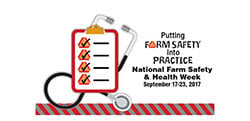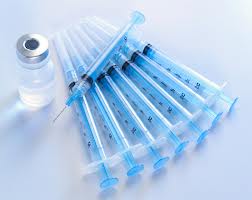National Farm and Safety Health Week is September 17 to 23, 2017. This year's theme is "Putting Farm Safety Into Practice." According to National Education Center for Agricultural Safety (NECAS) this theme hits home and reminds us that it is everyone's responsibility for safety both on the farm and the rural roadways of America.
Topics: agriculture, events & activities, farm
Running a Farm Safety Program: Getting Employee & Management Buy-In.
Your farm-safety program doesn’t have to be complicated, but, for it to work, everyone in the operation needs to buy into it. These seven steps will help you convince managers and employees to take ownership of the safety program and drive the safety agenda.
Topics: safety culture, safety training program, agriculture
Farm Safety Tips: Respiratory Protection and Keeping You Safe
Ah, the great outdoors—crisp, clean air and the refreshing smell of morning dew! Yes, this is just one of the reasons many of us really love farming. On the other hand, does farming generate hazards for our respiratory systems? Not only is the answer a resounding “yes,” but some of the most treacherous respiratory dangers are actually unique to farming.
Topics: air/respiratory, agriculture, chemicals
Calculating an OSHA Penalty
Topics: OSHA law & compliance, agriculture
Are Safety-Training Videos Enough to Meet OSHA Compliance?
For agribusiness owners considering options for employee safety training, the question often arises--Will videos alone satisfy OSHA requirements, or do I have to hire a safety expert to come on site and conduct some kind of formal training?
Topics: agriculture
Personal Protective Equipment: The Most Important Tool in Your Toolbox
Generally speaking, agriculture doesn’t place enough emphasis on personal protective equipment (PPE). Failure to use PPE can have devastating consequences in both the short-term and long-term.
We’ve all been there.
- Not wearing gloves when you know flowing material has sharpened the edges of the equipment you are working on to a razor edge.
- Not wearing goggles when you know the chemical you are using could harm your eyes.
- Purchasing boots without steel toes out of concern for comfort when you know the steel toe version would better protect your feet.
- Not using ear muffs when we are running the chainsaw even though you know your ears will ring for days afterwards.
With limited specific OSHA training regulations for agriculture, you might think that you have covered all your bases in your safety training and meeting OSHA's training requirements. On the contrary, staying current on all OSHA requirements is an ongoing project for you and your safety team.
Safety issues must become a top priority. That means creating a strategy that safeguards your employees’ and managers’ safety and fosters a solid expectation for everyone’s complete compliance with OSHA guidelines. These goals will help establish the foundation of a safety culture that, in turn, could lead to higher productivity and profits for your operation.
Topics: OSHA law & compliance, agriculture
A dairyman was in a hurry to get some heifers treated and when going over a gate, accidentally stuck a syringe filled with a powerful cattle treatment drug in his leg, just above the knee. He was unconscious before he hit the ground and laid in snow and mud for around four hours before waking up just enough to call for help. A quick-thinking family member called their veterinarian so he could contact the EMT’s to be sure they used the right treatment. If they had used their standard procedure for this type of reaction, they would have killed him instantly. Still, he had to be revived three times on the way to the hospital.
Topics: pharmaceutical handling, agriculture, farm, chemicals
I caught up with a friend last week who owned a large dairy farm and now works for a farm co-op in his “retirement.” When I mentioned ag-safety programs and OSHA compliance, he quickly rolled his eyes and sarcastically said, “Ugh,” with a chuckle.
Topics: safety training program, OSHA law & compliance, agriculture, farm
Important components of ag safety are knowledge and information. Knowing the pharmaceuticals being used on your farm today and knowing how to administer them is key to protecting farm workers, animals, consumers and environment. Today's medicines and chemicals are safer but only if the label instructions and manufacturer recommended safety precautions are followed.
Topics: pharmaceutical handling, agriculture












